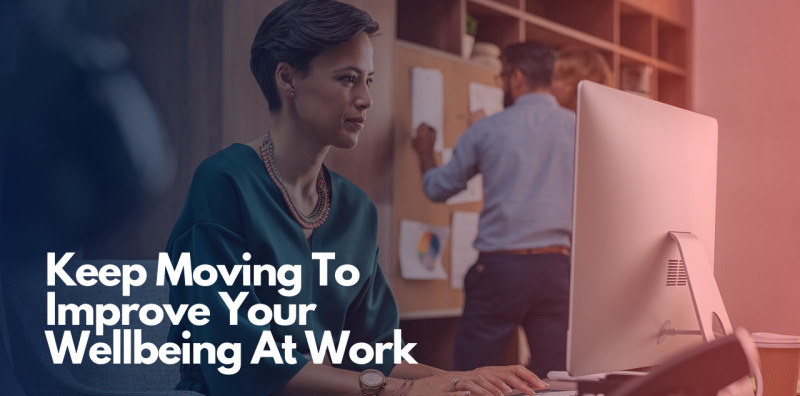- There is one basic yet attainable change that every employee can do to help promote better wellbeing: movement.
- It’s very unhealthy to sit down for extended periods as it can increase spine pressure and reduce enzymes responsible for burning fat.
- To build movement into your work day, consider using a height adjustable desk or setting reminders on your phone or computer to take regular breaks.
As you read this, what is your posture like?
Are you balanced on a kitchen bar stool at home or sitting crooked at your office desk?
It’s easy to fall into unhealthy habits throughout the working day, such as slouching or not taking enough breaks. If you’re working from home, the temptation to work long hours only amplifies the problem, which can lead to fatigue, stress and potentially burnout.
But sometimes the source of the problem is mechanical in nature. If your office chair doesn’t provide the right support, or if your desk is too high or low, it can cause additional health problems such as neck and back pain.
A workplace that promotes wellbeing requires much more than just good chairs; there are 7 dimensions of workplace wellness that range from the physical to the emotional, and each dimension can be addressed in different ways in the workplace.
In the meantime, there is one basic yet attainable change that every employee can do to help promote better wellbeing: movement.
Movement and Mobility
For some time, the threat of ‘sitting is the new smoking’ has been the call to action for workplaces, and with the line between work and home life virtually nonexistent, it’s essential for people to create as much movement in their working day as possible.
“Moving is critical. Move around between calls, take breaks, or walk to work”
Adrian McClenagh, Humanscale (speaking at Future WorkTech Forum 2020)
“Remember to adjust your position as often as you can,” said Adrian McClenagh, Managing Consultant for workplace design and furniture manufacturer Humanscale, who spoke at the recent Future WorkTech Forum 2020.
“It’s very unhealthy to sit down for extended periods. It increases spine pressure and reduces enzymes responsible for burning fat.
“Moving is critical. Move around between calls, take breaks, or walk to work if you can.”
Suggested Reading: 4 Ways to Combat Back Pain as a Remote Worker
Adjustable height desks can help create movement throughout the day as workers can mix up their sitting and standing time.
If you have an adjustable height desk, McClenagh advises the following mix of sitting and standing:
“In every half hour period, sit for 20 minutes, stand for 8 mins, and spend 2 minutes walking or stretching. Do at least 2 sit-stand transitions every hour.”
For homes or workplaces that don’t have adjustable height desks, you can still build movement into your day. Set reminders on your smartphone or use a free app, such as Stretchly, Stand Up!, or Stretching Exercises at Home.
Guide to a Healthier Home Workplace
For those times when you do have to sit in front of a screen, make sure your workstation is adjusted to the correct height and angle. Humanscale’s 11-point guide to a healthy workstation offers the following advice:
When Sitting:
1. Raise or lower the seat to ensure your thighs are parallel to the floor with your feet flat on the floor or a footrest.
2. Adjust seat pan depth to maintain two inches of clearance between the back of your knees and the front edge of the seat.
3. Adjust backrest height to comfortably fit the small of your back.
4. Adjust the recline tension, if necessary, to support varying degrees of recline throughout the day. Avoid the use of recline locks.
5. Lean back and relax in your chair to allow the backrest to support your upper body.
When Typing:
6. Use an articulating keyboard support and position it 1 to 1.5 inches above your thighs. Angle the keyboard away from your body to keep wrists straight while typing. Rest your palms—not your wrists—on a palm support.
Using a Mouse:
7. Position your mouse close to the keyboard or over the numeric keypad to minimize reaching. Avoid anchoring your wrist on the desk. Instead, glide the heel of your palm over the mousing surface and use your entire arm to mouse.
Head Position:
8. Position the monitor at least an arm’s length away with the top line of text at or slightly below eye level. Tilt the monitor away from you so your line of sight is perpendicular to the monitor.
Lighting:
9. Position a task light to the side opposite your writing hand. Shine it on paper documents but away from computer monitors to reduce glare.
Alignment:
10. Align the monitor and spacebar with the midline of your body and arrange frequently used work tools within easy reach. Prop reference documents between your body and the monitor with an in-line document holder.
Rest:
11. Take two or three 30- to 60-second breaks each hour to allow your body to recover from periods of repetitive stress.







